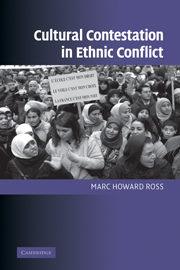Book contents
- Frontmatter
- Contents
- List of figures
- Preface
- 1 Introduction: easy questions and hard answers, what are they fighting about?
- 2 The political psychology of competing narratives
- 3 Narratives and performance: ritual enactment and psychocultural dramas in ethnic conflict
- 4 Loyalist parades in Northern Ireland as recurring psychocultural dramas
- 5 Where is Barcelona? Imagining the nation without a state
- 6 Digging up the past to contest the present: politics and archeology in Jerusalem's Old City
- 7 Dressed to express: Islamic headscarves in French schools
- 8 The politics of memory and memorialization in post-apartheid South Africa
- 9 Enlarging South Africa's symbolic landscape
- 10 Flags, heroes, and statues: inclusive versus exclusive identity markers in the American South
- 11 Culture's central role in ethnic conflict
- References
- Index
- Cambridge Cultural Social Studies
3 - Narratives and performance: ritual enactment and psychocultural dramas in ethnic conflict
Published online by Cambridge University Press: 22 September 2009
- Frontmatter
- Contents
- List of figures
- Preface
- 1 Introduction: easy questions and hard answers, what are they fighting about?
- 2 The political psychology of competing narratives
- 3 Narratives and performance: ritual enactment and psychocultural dramas in ethnic conflict
- 4 Loyalist parades in Northern Ireland as recurring psychocultural dramas
- 5 Where is Barcelona? Imagining the nation without a state
- 6 Digging up the past to contest the present: politics and archeology in Jerusalem's Old City
- 7 Dressed to express: Islamic headscarves in French schools
- 8 The politics of memory and memorialization in post-apartheid South Africa
- 9 Enlarging South Africa's symbolic landscape
- 10 Flags, heroes, and statues: inclusive versus exclusive identity markers in the American South
- 11 Culture's central role in ethnic conflict
- References
- Index
- Cambridge Cultural Social Studies
Summary
Introduction
Contested cultural expressions are frequently focal points in ethnic conflict. In these conflicts, psychocultural narratives and identities are invoked and reinforced through public actions. Participation in these expressions can be fleeting or prolonged, mundane or esoteric, active or passive, and easy or costly. Some actions are highly marked and occur only on particular days in special, sacred places while others are ordinary, everyday behaviors (Kertzer 1988). What are crucial to all of them, however, are the almost automatic affective connections people make between the symbolic expressions and the within-group bonds they strengthen.
Most public behaviors produce few strong reactions. The public contentious expressions that do spark strong and contrasting reactions organized around divergent social and political identities are those of particular interest here. These expressions provoke intense in-group feelings that we variously call patriotism, nationalism, ethnic pride, or group loyalty, as well as out-group fear and anger. At the same time, it is not the forms of expression themselves that do this; most parades, museum presentations, athletic contests, concerts, and religious ceremonies are just reassuring or entertaining. How is it, then, that the range of reactions to the same cultural expressions varies from reassuring to entertaining to threatening? The answer is that understanding cultural expressions and performances means considering not just the nature and content of the events but also how in-group and out-group audiences respond to them.
- Type
- Chapter
- Information
- Cultural Contestation in Ethnic Conflict , pp. 63 - 87Publisher: Cambridge University PressPrint publication year: 2007



